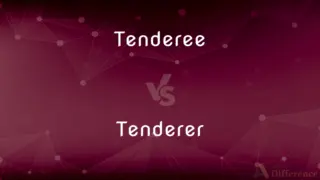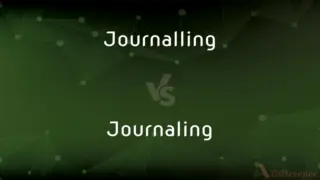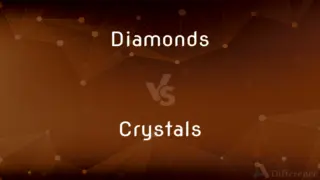Elasticated vs. Elastic — What's the Difference?
By Fiza Rafique & Maham Liaqat — Updated on May 3, 2024
Elasticated refers to items with elastic fabric incorporated, enhancing flexibility; elastic describes the material itself, known for its stretchability.

Difference Between Elasticated and Elastic
Table of Contents
ADVERTISEMENT
Key Differences
Elasticated garments are typically designed with sections or whole parts made from or containing elastic materials to ensure a snug fit, whereas elastic is the actual stretchable material, such as bands or threads, used in various applications. Elastic is a key component in the design of elasticated products, ensuring they can stretch and return to their original shape.
Elasticated materials are often found in clothing like waistbands or cuffs, offering adjustability and comfort, while elastic materials can be used broadly in both clothing and other sectors like medical and fitness for their flexibility. Elastic materials provide the foundational stretch properties that elasticated items rely on for functionality.
In the context of manufacturing, elasticated describes the process or result of incorporating elastic into products, enhancing their usability and fit; on the other hand, elastic is manufactured in various forms such as strips, bands, or woven into fabrics, ready to be integrated into products or used standalone.
Consumer products often feature elasticated parts to accommodate different body sizes or uses, making items like socks, underwear, and masks more adaptable. In contrast, elastic as a raw material is versatile and essential in crafting these elasticated elements, proving crucial in diverse applications beyond clothing, such as in crafting and packaging.
Comparison Chart
Definition
Refers to items containing or composed of elastic material
A stretchable material
ADVERTISEMENT
Usage in Products
Used to describe parts of products designed with elasticity
Used as a component in products
Industries
Predominantly in clothing and accessories
Broad, including medical, fitness, and crafting
Functionality
Provides adjustability and comfort
Provides the ability to stretch and return to original shape
Example of Use
Elasticated waistbands in trousers
Elastic bands used in fitness routines
Compare with Definitions
Elasticated
Highlights the incorporation of elastic in parts of garments.
The elasticated cuffs prevented the sleeves from moving too much.
Elastic
Describing something that can easily stretch and recover.
The elastic fabric made the dress very comfortable.
Elasticated
Involves integrating elastic to enhance usability.
The elasticated features of the backpack made it more comfortable.
Elastic
A flexible, stretchable fabric made from rubber or plastic.
The mask featured an elastic band to ensure a tight fit.
Elasticated
Common in areas requiring flexible fit.
Elasticated leggings are popular for their comfort and style.
Elastic
Used in various applications for providing stretch.
The elastic straps are essential for securing the package.
Elasticated
Describing items made with or containing elastic materials.
His pants were elasticated at the waist for better fit.
Elastic
Capable of returning to its original shape after being stretched.
She appreciated the elastic nature of her new yoga pants.
Elasticated
Focuses on comfort and adaptability.
Elasticated fabric in shoes makes them easy to wear.
Elastic
Often used in garments to improve fit.
Elastic in the cuffs keeps the sleeves from slipping.
Elasticated
(of a garment or material) made elastic by the insertion of rubber thread or tape
Trousers with elasticated waists
Elastic
Easily resuming original size or shape after being stretched or otherwise deformed; flexible.
Elasticated
Of clothing or part of a garment, containing a strip or strips of elastic, especially in the waistband, cuffs or the ends of the legs, in order to make the clothing fit snugly.
An elasticated jacket
Slacks with an elasticated waistband
Elastic
Relating to a collision in which the total kinetic energy is conserved.
Elastic
Quick to recover, as from disappointment; resilient
An elastic spirit.
Elastic
Capable of being adapted to change or a variety of circumstances
"To say that morale is a highly unscientific and quite elastic concept would be an understatement" (Roger J. Spiller).
Elastic
(Economics) Of, relating to, or being a good for which changes in price have a large effect on the quantity demanded or supplied.
Elastic
A flexible stretchable fabric made with interwoven strands of rubber or an imitative synthetic fiber.
Elastic
An object made of this fabric.
Elastic
A rubber band.
Elastic
Capable of stretching; particularly, capable of stretching so as to return to an original shape or size when force is released.
The rope is somewhat elastic, so expect it to give when you pull on it.
Elastic
Made of elastic.
Elastic band
Elastic
Of clothing, elasticated.
Elastic
(economics) Sensitive to changes in price.
Demand for entertainment is more elastic than demand for energy.
Elastic
Springy; bouncy; vivacious
Elastic
Pervasive, all-encompassing.
Elastic
Able to return quickly to a former state or condition, after being depressed or overtaxed; having power to recover easily from shocks and trials.
Elastic spirits; an elastic constitution
Elastic
(uncountable) An elastic material used in clothing, particularly in waistbands and cuffs.
Running shorts use elastic to eliminate the need for a belt
Elastic
(countable) An elastic band.
Elastic
Springing back; having a power or inherent property of returning to the form from which a substance is bent, drawn, pressed, or twisted; springy; having the power of rebounding; as, a bow is elastic; the air is elastic; India rubber is elastic.
Capable of being drawn out by force like a piece of elastic gum, and by its own elasticity returning, when the force is removed, to its former position.
Elastic
Able to return quickly to a former state or condition, after being depressed or overtaxed; having power to recover easily from shocks and trials; as, elastic spirits; an elastic constitution.
Elastic
An elastic woven fabric, as a belt, braces or suspenders, etc., made in part of India rubber.
Elastic
A narrow band of elastic rubber used to hold things (such as papers) together
Elastic
An elastic fabric made of yarns containing an elastic material
Elastic
Capable of resuming original shape after stretching or compression; springy;
An elastic band
A youthful and elastic walk
Elastic
Able to adjust readily to different conditions;
An adaptable person
A flexible personality
An elastic clause in a contract
Common Curiosities
Is elastic available in different strengths?
Yes, elastic comes in various thicknesses and strengths for different applications.
Are elasticated products only for clothing?
No, elasticated designs are used in various products, including accessories and home goods.
Why use elastic in clothing?
Elastic is used in clothing for better fit and comfort, accommodating various body sizes.
Are there environmental concerns associated with elastic materials?
Yes, synthetic elastic materials can pose environmental concerns due to their non-biodegradable nature, prompting interest in more sustainable alternatives.
Can all elastic materials be used for elasticated designs?
Yes, all elastic materials can be adapted for elasticated designs to enhance flexibility.
Is there a difference in the cost between elasticated products and non-elasticated products?
Typically, elasticated products might be slightly more expensive due to the additional material and the complexity of integrating elastic.
Can elastic be recycled?
While recycling elastic can be challenging due to its material composition, some initiatives and technologies are exploring ways to recycle elastic materials.
How does the quality of elastic affect the comfort of elasticated items?
The quality of elastic can significantly affect comfort, with higher-quality elastic providing better stretch and durability.
What is the difference between elasticated and elastic?
Elasticated refers to items designed with elastic, whereas elastic is the material itself.
Can elastic degrade over time?
Yes, elastic can lose its stretchability and become brittle over time, especially if exposed to elements like heat, chemicals, and repeated stretching.
How do manufacturers choose the right type of elastic for a product?
Manufacturers consider factors like elasticity, strength, and durability, as well as the product's intended use and required comfort level.
What types of clothing typically use elasticated designs?
Common types of clothing with elasticated designs include underwear, swimwear, sportswear, and any garment requiring a flexible fit.
How do elastic and elasticated components affect the overall design of a product?
Elastic and elasticated components are crucial in design for providing flexibility, ensuring a good fit, and adding aesthetic value to the product through functional design elements.
What innovations are occurring in the field of elastic materials?
Innovations include the development of eco-friendly elastic materials and improvements in elasticity and durability to meet various demands.
How do consumers care for elasticated garments to maintain their elasticity?
Care for elasticated garments includes washing in cold water, avoiding high heat drying, and using mild detergents to maintain elasticity.
Share Your Discovery

Previous Comparison
Khimar vs. Hijab
Next Comparison
Bulldozer vs. LoaderAuthor Spotlight
Written by
Fiza RafiqueFiza Rafique is a skilled content writer at AskDifference.com, where she meticulously refines and enhances written pieces. Drawing from her vast editorial expertise, Fiza ensures clarity, accuracy, and precision in every article. Passionate about language, she continually seeks to elevate the quality of content for readers worldwide.
Co-written by
Maham Liaqat











































